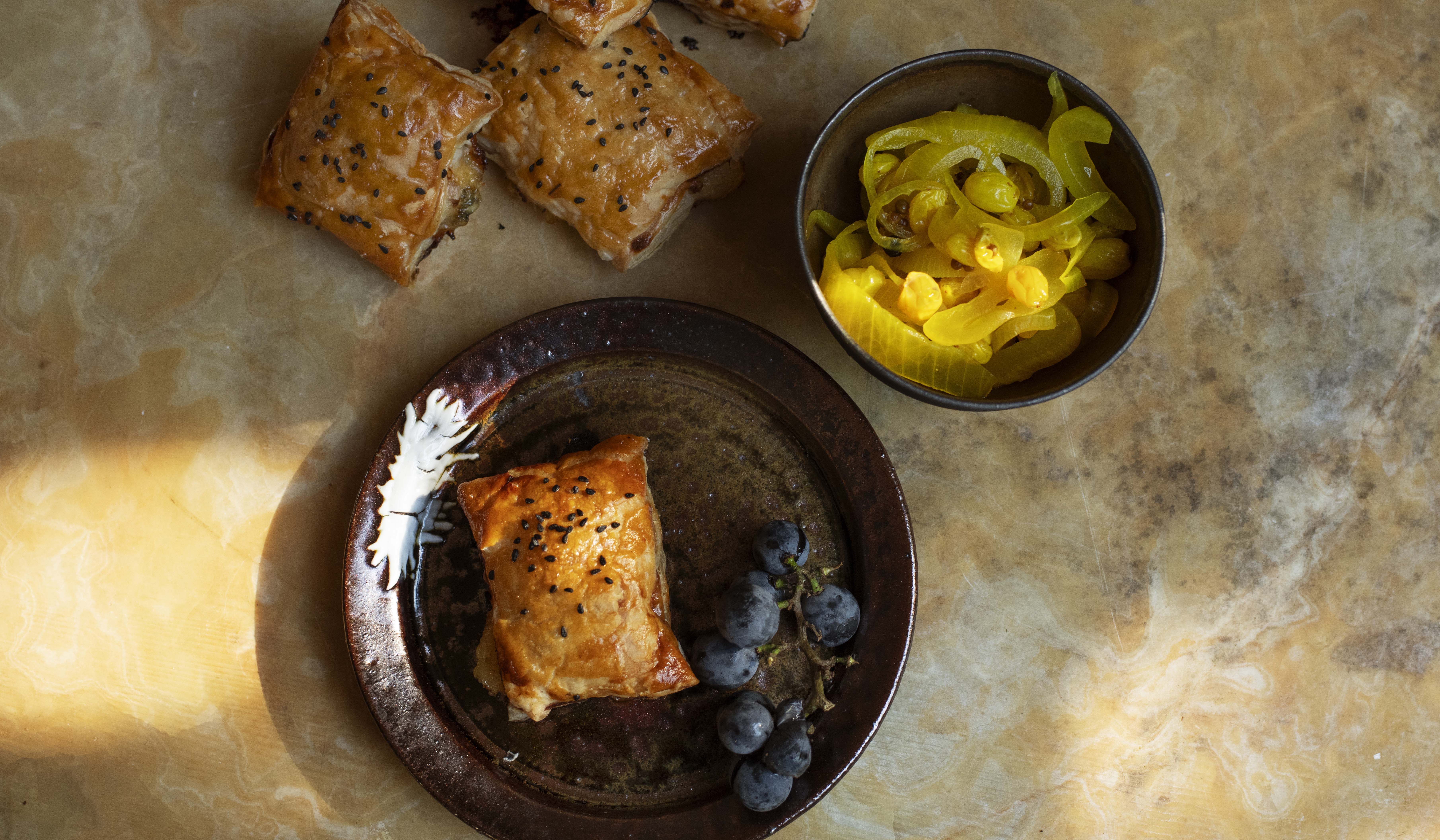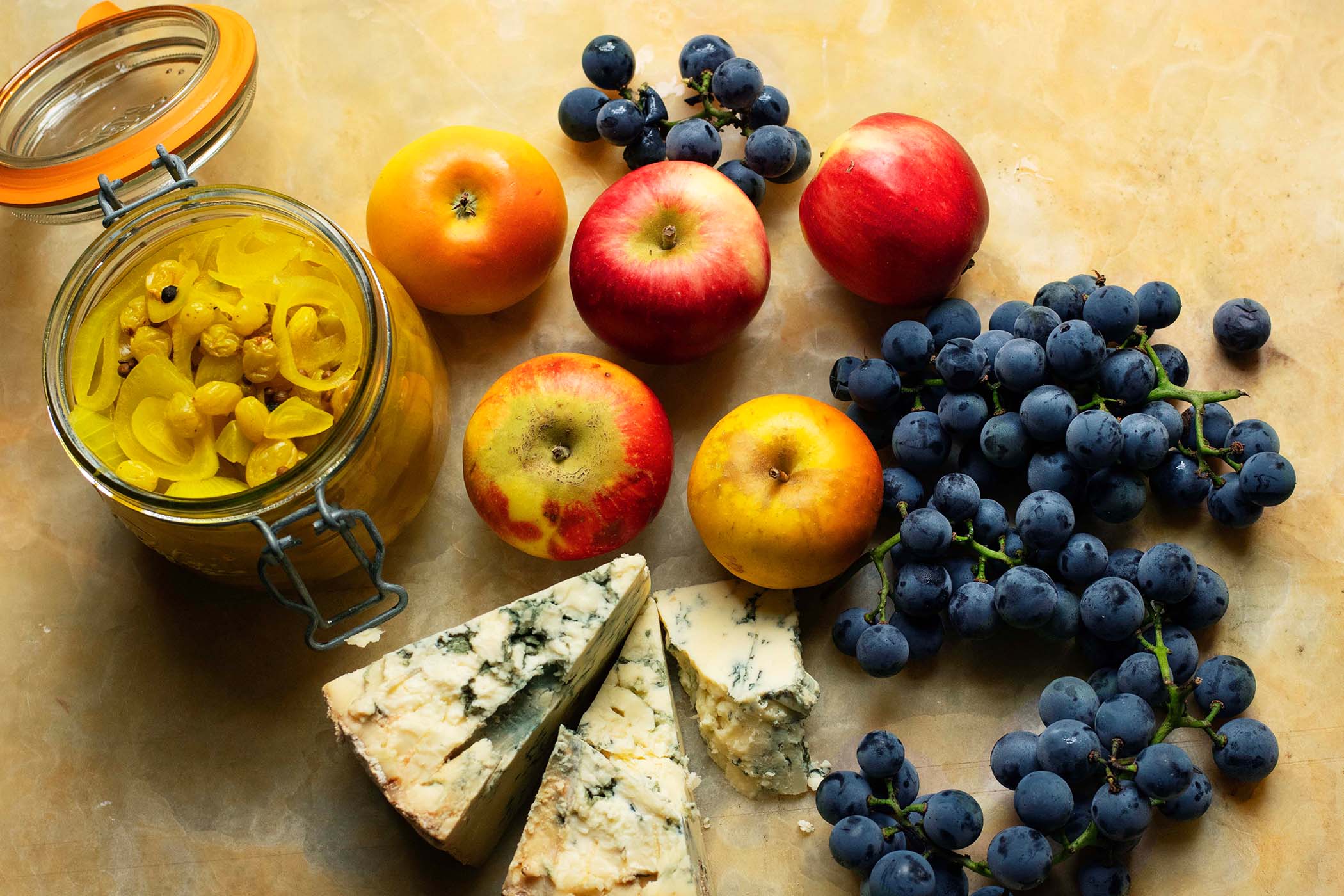Photographs by Jonathan Lovekin
I climbed the apple trees in the orchard as much as my vertigo would let me, then left my father to reach those on the tallest branches. Some I would catch as he sent them hurtling earthwards, others I would miss (to his scorn). It was my job each autumn to wrap each fruit in newspaper and store them in the cellar for winter, when they would reappear in pies, sauce for roast pork and under crumble crusts.
The apple season is in full swing and my local shops and farmers’ market have crates of singularly British varieties grown in small orchards, as they have been for centuries. If you are lucky, you may find Falstaff, Ashmead’s Kernel and September Wonder, late Discovery (an early apple, but a few still around) and varieties of frothy-fleshed cooking apples other than the ubiquitous Bramley. They come in shades of crimson, yellow and green, their skins flushed with rust or orange, smooth and shiny, or freckled with the rough, russet skin. Eat them now, while they are at their best. I have crunched at least two a day since the season started. There is barely an apple I do not like.
The first recipe I ever had published was a strudel of apple and cheese, a savoury pastry I make to this day. A properly made strudel is something for hobby cooks who are happy to go into battle with the stretchy pastry the size of a bedsheet. I prefer to use puff pastry, rolling it out as thin as possible and making not one long parcel but a batch of small ones, little dumplings, puffed up like cushions, oozing their filling of fluffy apple and string of blue cheese. I often make these at Christmas to put on the table with mulled wine.
The pears come online later – my own are still on the espalier outside the kitchen door, hard as rock even if they are turning a deep chartreuse. I bought some cherubic Comice the other day, peeled and cored them and cooked four of them in a white wine syrup with the juice of a lemon and black pod of vanilla. I intended to serve them chilled, but the smell of the vanilla and sweet fruit syrup begged them to be eaten immediately, the warm syrup like silk.
I also made a crumble with pears and nuggets of dark chocolate. Their flesh can be drier than apples, so I fried them first with a little sugar and butter, then covered them in a blanket of crumble.
Even without any sun, there is a daily salad on the table. The usual tangle of crisp and bitter leaves – watercress, frisée and soft, mild butterhead – but with a warm ingredient thrown in. Snippets of fatty bacon or pancetta, apples or pears fried in butter (wonderful with crisp white chicory) or crumbled and fried black pudding.
The new season’s nuts are here too, almonds to fry with butter and salt and toss into spinach salads; walnuts to add to a coffee cake or apple pie and hazelnuts to eat from the palm of your hand. The best are pale and milky right now, sweet enough to eat straight from their shells, perhaps with a glass of chilled fino or a glass of cold, sparkling cider. It is time to get the nutcrackers out.

Apples and cheese: a marriage made in heaven
Apple and stilton dumplings
Little puff-pastry dumplings with the time-honoured filling of apples and cheese. The onion pickle adds a pleasingly sharp note. They are almost as good cold (packed lunch, autumn picnic, midnight snack) as they are when eaten hot. It is worth taking care to seal them tightly to stop the filling leaking as they bake.
Makes 12. Ready in 50 minutes.
apples 500g (3 medium apples)water 3 tbsppuff pastry 1 x 320g sheetstilton or other blue cheese 150gegg 1, large, beatennigella seeds 2 tsp
Peel and core the apples, then roughly chop them. Put them in a stainless-steel saucepan with the water and simmer for a few minutes until soft. Stir them occasionally to stop them sticking, then crush them to a rough purée with a fork. You are after a filling that is soft, but not runny. Set aside to cool.
Preheat the oven to 200C/gas mark 6. Cut the pastry in half, placing one half back in the fridge. Then, on a floured board, roll out the remaining half to measure 24cm x 30cm. Cut into 12 equal rectangles. Crumble the stilton and stir into the apple, then place 1½ heaped tbsp of the mixture into the centre of 6 of the pieces of pastry. Brush the edges of each with beaten egg, then place the remaining pieces over the filling and seal each one with your fingertips.
Transfer the little dumplings to a baking sheet and keep cool. Repeat with the remaining pastry, again making a further 6 dumplings. Brush each with beaten egg and scatter with nigella seeds.
Bake the pastries in the preheated oven for 20 minutes or until golden. Transfer to a rack for 10 minutes, then serve while they are still warm, with the pickle below.
Onion pickle
Makes 1 medium jar. Ready in 30 minutes.
onions 2, mediumcaster sugar 1 tbspcider vinegar 6 tbspmalt vinegar 1 tbspblack peppercorns 10coriander seeds 1 tspground turmeric ½ tspcloves 3|water 200mlsea salt 1 tspgolden raisins 50g
Peel and thinly slice the onions, put them in a stainless-steel saucepan and add the sugar and vinegars. Add the peppercorns, coriander seeds, turmeric and cloves, water and salt. Bring the mixture to the boil, lower the heat to a simmer, then cover with a lid and continue cooking for 10 minutes. Keep a watchful eye on the liquid level, adjusting the heat as necessary. Stir in the raisins and set aside. Transfer the hot pickle to a clean storage jar, seal and store in the fridge.

